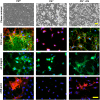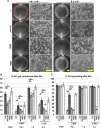Impaired Contracture of 3D Collagen Constructs by Fibronectin-Deficient Murine Fibroblasts
- PMID: 30890950
- PMCID: PMC6413635
- DOI: 10.3389/fphys.2019.00166
Impaired Contracture of 3D Collagen Constructs by Fibronectin-Deficient Murine Fibroblasts
Abstract
Fibronectin (FN) is an extracellular matrix glycoprotein that is abundantly expressed by fibroblasts in contracting wounds, where it mediates cell adhesion, migration and proliferation. FN also efficiently binds to collagen. Therefore, we and others hypothesized that FN and its cellular receptor integrin α5β1 might be involved in collagen matrix contracture by acting as linkers. However, there are conflicting reports on this issue. Moreover, several publications suggest an important role of collagen-binding integrin receptors α2β1 and α11β1 in collagen matrix contracture. Therefore, the aim of the present study was to determine the contributions of FN-integrin α5β1 interactions relative to those of collagen receptors α2β1 and α11β1 in this process. To assess the role of cellular FN directly, we employed FN-deficient mouse fibroblasts, subjected them to a collagen gel contracture assay in vitro, and compared them to their wildtype counterparts. Exogenous FN was removed from serum-containing medium. For dissecting the role of major collagen receptors, we used two FN-deficient mouse fibroblast lines that both possess integrin α5β1 but differ in their collagen-binding integrins. Embryo-derived FN-null fibroblasts, which express α11- but no α2-integrin, barely spread and tended to cluster on collagen gels. Moreover, FN-null fibroblasts required exogenously added FN to assemble α5β1-integrin in fibrillar adhesion contacts, and to contract collagen matrices. In contrast, postnatal kidney fibroblasts were found to express α2- but barely α11-integrin. When FN expression was suppressed in these cells by shRNA transfection, they were able to spread on and partially contract collagen gels in the absence of exogenous FN. Also in this case, however, collagen contracture was stimulated by adding FN to the medium. Antibody to integrin α5β1 or RGD peptide completely abolished collagen contracture by FN-deficient fibroblasts stimulated by FN addition. We conclude that although collagen-binding integrins (especially α2β1) can mediate contracture of fibrillar collagen gels by murine fibroblasts to some extent, full activity is causally linked to the presence of pericellular FN and its receptor integrin α5β1.
Keywords: alpha5-integrin; collagen; collagen contraction; collagen contracture; fibroblasts; fibronectin.
Figures







Similar articles
-
The mesenchymal alpha11beta1 integrin attenuates PDGF-BB-stimulated chemotaxis of embryonic fibroblasts on collagens.Dev Biol. 2004 Jun 15;270(2):427-42. doi: 10.1016/j.ydbio.2004.03.006. Dev Biol. 2004. PMID: 15183724
-
Collagen Assembly at the Cell Surface: Dogmas Revisited.Cells. 2021 Mar 16;10(3):662. doi: 10.3390/cells10030662. Cells. 2021. PMID: 33809734 Free PMC article. Review.
-
Human fibroblasts with mutations in COL5A1 and COL3A1 genes do not organize collagens and fibronectin in the extracellular matrix, down-regulate alpha2beta1 integrin, and recruit alphavbeta3 Instead of alpha5beta1 integrin.J Biol Chem. 2004 Apr 30;279(18):18157-68. doi: 10.1074/jbc.M312609200. Epub 2004 Feb 17. J Biol Chem. 2004. PMID: 14970208
-
Type III and V collagens modulate the expression and assembly of EDA(+) fibronectin in the extracellular matrix of defective Ehlers-Danlos syndrome fibroblasts.Biochim Biophys Acta. 2012 Oct;1820(10):1576-87. doi: 10.1016/j.bbagen.2012.06.004. Epub 2012 Jun 15. Biochim Biophys Acta. 2012. PMID: 22705941
-
Shaping Up the Tumor Microenvironment With Cellular Fibronectin.Front Oncol. 2020 Apr 30;10:641. doi: 10.3389/fonc.2020.00641. eCollection 2020. Front Oncol. 2020. PMID: 32426283 Free PMC article. Review.
Cited by
-
Recombinantly expressed rhFEB remodeled the skin defect of db/db mice.Appl Microbiol Biotechnol. 2024 Jan 29;108(1):183. doi: 10.1007/s00253-024-13021-9. Appl Microbiol Biotechnol. 2024. PMID: 38285241 Free PMC article.
-
Discovery and characterization of heterogeneous and multipotent fibroblast populations isolated from excised cleft lip tissue.Stem Cell Res Ther. 2022 Sep 8;13(1):469. doi: 10.1186/s13287-022-03154-x. Stem Cell Res Ther. 2022. PMID: 36076255 Free PMC article.
-
Recombinant human fibronectin segment (rhFN1024) hydrogel carried hPDLSCs to repair diabetic trauma by activated NF-κB signaling pathway.Regen Biomater. 2025 May 15;12:rbaf027. doi: 10.1093/rb/rbaf027. eCollection 2025. Regen Biomater. 2025. PMID: 40438201 Free PMC article.
-
Bioactivity effects of extracellular matrix proteins on apical papilla cells.J Appl Oral Sci. 2021 Sep 3;29:e20210038. doi: 10.1590/1678-7757-2021-0038. eCollection 2021. J Appl Oral Sci. 2021. PMID: 34495108 Free PMC article.
-
Extravillous trophoblasts reverse the decidualization induced increase in matrix production by secreting TGFβ antagonists Emilin-1 and Gremlin-1.Cells Dev. 2025 Mar;181:203994. doi: 10.1016/j.cdev.2025.203994. Epub 2025 Jan 3. Cells Dev. 2025. PMID: 39756583
References
LinkOut - more resources
Full Text Sources
Miscellaneous

